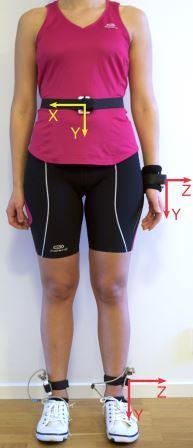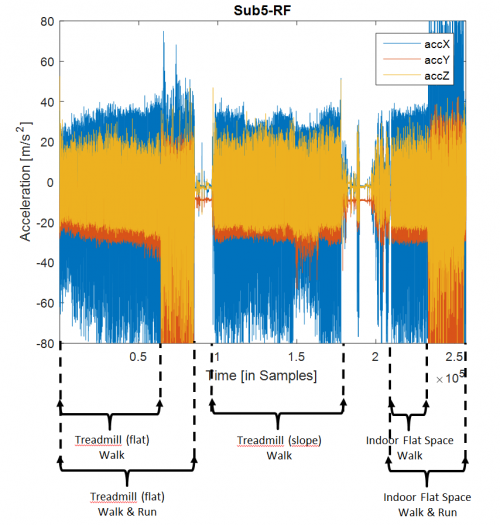Gait database
Contents
MAREA (Movement Analysis in Real-world Environments using Accelerometers) Gait Database

The MAREA gait database comprises of gait activities in different real-world environments as shown in the table below. 20 healthy adults (12 males and 8 females, average age: 33.4 +- 7 years, average mass: 73.2 +- 10.9 kg, average height: 172.6 +- 9.5 cm) participated in the study that was approved by the Ethical Review Board of Lund, Sweden. Each subject had a 3-axes Shimmer3 (Shimmer Research, Dublin, Ireland) accelerometer (+- 8g) attached to their waist, left wrist and left and right ankles using elastic bands and velcro straps. Figure 1 shows the position and orientation of each accelerometer at the beginning of each experiment. On the waist, the accelerometer X and Y axes were pointing to the lateral and downward direction, respectively. On the wrist and left ankle, the Z axis was pointing in the lateral direction while the Y axis was pointing downward and was aligned with the limb longitudinal axis. In order to simulate a lesser controlled scenario, the accelerometer on right ankle was positioned such that the Y axis was pointing downward but the Z axis was marginally disturbed such that it was not exactly perpendicular to the sagittal plane. The subjects were provided shoes that were instrumented with piezo-electric force sensitive resistors (FSRs), fixed at the extreme ends of the sole in order to provide the ground truth values for HS and TO. An external expansion board was used to synchronously collect the data from the FSRs on each foot and the respective ankle accelerometer, at a sampling frequency of 128Hz, and stored locally on the Shimmer3 microSD card. Due to the lack of a centralized data logger, the waist accelerometer was not in perfect synchronization with the ankle accelerometer.
| Subjects | Environment | Activity | Speed | Duration | Short Description |
|---|---|---|---|---|---|
| 11 | Treadmill (flat) | Walk & run | 4km/hr - 8km/hr; increasing in steps
of 0.4km/hr every minute |
10 min | Start walking and switch to
running at self-selected speed |
| Treadmill (slope) | Walk | Self-selected | 12 min | Treadmill is set to (5, 0, 10, 0, 15, 0) degree
inclinations with 2 mins at each angle | |
| Indoor flat space | Walk & run | Self-selected | 6 min | Start walking and switch
to running after 3 mins | |
| 9 | Outdoor street | Walk & run | Self-selected | 6 min | Start walking and switch
to running after 3 mins |
Explanation of the database files (download link below)
1. Activity Timings
There are two matrices provided, namely, Indoor Experiment timings and Outdoor Experiment timings which contain the timing information of the activities and are included in a folder called Activity Timings.zip:
- Indoor Experiment Timings: This 11(rows) x 8(columns) matrix consists of sample numbers corresponding to the start and end of an activity, for a given subject, for the Indoor Experiments, i.e.
- Treadmill (flat)
- Treadmill (slope)
- Indoor flat space.
The figure below explains how to extract the sample nos. corresponding to an activity for a given subject, from the Indoor Experiment timings matrix.
- Outdoor Experiment Timings: This 9(rows) x 3(columns) matrix consists of sample numbers corresponding to the start and end of an activity, for a given subject, for the Outdoor Street Experiments. The figure below explains how to extract the sample nos. corresponding to an activity for a given subject, from the Outdoor Experiment timings matrix.
2. Subject Data
The Subject data files are provided in two formats, namely, .mat format (Subject Data_mat format.zip) and .txt format Subject Data_txt format).zip. The naming convention of the files is: Sub<number>_<position>, where:
- <number>: stands for Subject number and ranges from 1 to 20.
- <position>: stands for the position of the accelerometer on the body as shown in Figure 1. The positions are:
- LF - Left Ankle
- RF - Right Ankle
- Wrist
- Waist
For each Subject file, eg. Sub5_RF, the accelerometer data from the 3 axis accelerometer is stored in 3 columns (separated using comma in the .txt files), each named as:
- accX - data from X - axis
- accY - data from Y - axis
- accZ - data from Z - axis
3. Ground Truth
The Ground Truth is provided as a 11x7 structure that gives the timing of the Heel-Strike and Toe-Off events extracted from the FSR signals. This timing information is provided in terms of sample numbers and is relative to each activity. The structure consists of 7 fields that have already been segregated using the Indoor Experiment Timings and Outdoor Experiment Timings explained above:
- treadWalk - treadmill (flat) walk
- treadIncline - treadmill (slope) walk
- treadWalknRun - treadmill (flat) walk & run
- indoorWalk - indoor (flat space) walk
- indoorWalknRun - indoor (flat space) walk & run
- outdoorWalk - outdoor street walk
- outdoorWalknRun - outdoor street walk & run
Each row of the structure represents a Subject. For Indoor activities, Row 1 -> Subject1, ..., Row 11 -> Subject 11 and so on. For outdoor activities, Row 1 -> Subject 12,..., Row 9 -> Subject 20. As an example: GroundTruth(1).treadWalk provides the ground truth data for Subject 1 for treadmill (flat) walk. This is a structure with fields:
- SubIdx - Subject number. Ranges from Sub1 - Sub20
- LF_HS - Sample numbers of Heel-Strike event from Left Foot FSR signal.
- LF_TO - Sample numbers of Toe-Off event from Left Foot FSR signal.
- RF_HS - Sample numbers of Heel-Strike event from Right Foot FSR signal.
- RF_TO - Sample numbers of Toe-Off event from Right Foot FSR signal.
4. mainScript.m
This MATLAB script is an example on how to:
- Read the accelerometer data of a subject for an activity & position
- Read the Ground Truth Heel-Strike and Toe-Off gait events for the same
- Plot all the signals
1. Siddhartha Khandelwal, Nicholas Wickström, Evaluation of the performance of accelerometer-based gait event detection algorithms in different real-world scenarios using the MAREA gait database, Gait & Posture, Volume 51, January 2017, Pages 84-90, ISSN 0966-6362, http://dx.doi.org/10.1016/j.gaitpost.2016.09.023.
2. Siddhartha Khandelwal; Nicholas Wickström, "Gait Event Detection in Real-World Environment for Long-Term Applications: Incorporating Domain Knowledge into Time-Frequency Analysis," in IEEE Transactions on Neural Systems and Rehabilitation Engineering , vol. 24, no. 12, pp.1363-1372, 2016
3. Siddhartha Khandelwal, Nicholas Wickström, "Novel methodology for estimating Initial Contact events from accelerometers positioned at different body locations", in Gait & Posture, Volume 59, Pages 278–285, Jan 2018.
DOI: http://dx.doi.org/10.1016/j.gaitpost.2017.07.030
4. Siddhartha Khandelwal; Nicholas Wickström, "Identification of Gait Events using Expert Knowledge and Continuous Wavelet Transform Analysis", in BIOSIGNALS 2014, 7th International Conference on Bio-inspired Systems and Signal Processing, Angers, France, March 3-6, 2014
DiVA url: [5]
5. Siddhartha Khandelwal, Nicholas Wickström, "Detecting Gait Events from Outdoor Accelerometer Data for Long-term and Continuous Monitoring Applications" in 13th International Symposium on 3D Analysis of Human Movement (3D-AHM 2014), 14–17 July, 2014, Lausanne, Switzerland.
DiVA url: [6]




